Original at
http://mostra.clever.net/19/ingles/filmes/powell.htm
Michael Powell and Emeric Pressburger - Restored Classics
ENGLAND
Michael Powell (1905-1990) started film making at the age of 20
on director Rex Ingram's team in a studio in Nice, France. He
worked with silent films with Harry Lachman and Alfred Hitchcock
at the Elstree Studios.
In 1938, following The Edge of the World (1937), he worked
together with script writer Emeric Pressburger (born in Hungary
in 1902, died in England in 1988) to develop the project The
Spy in Black, with Conrad Veidt.
Pressburger began his career writing scripts in Germany and in
France, mainly for Robert Siodmark. Later, in 1936, he went to
London to work with Alexander Korda.
Powell made two more films with Pressburger (The Thief of Bagdad
and Contraband, both in 1940, also with Veidt) before
he started his own producing company, the Archers.
The most important Archers films include: A Canterbury Tale
(1944), Black Narcissus (1946), The Red Shoes(1948),
The Elusive Pimpernel (1950), and The Tales of Hoffmann
(1951), all of these chosen for the 19th International
Film Festival. These films will be shown with copies that
have been restored by the British Film Institute, within
the Champagne Piper Heidsieck Classic Film Collection.
After Powell and Pressburger closed down Archers in 1956, Powell's
most important film was Peeping Tom (1960). Pressburger
directed only one film on his own, Twice Upon a Time, in
1953, and he wrote the script for Operation Crossbow (1965),
by Michael Anderson. In 1972, they worked together once more on
a film for children, The Boy Who Turned Yellow.
Contraband
The captain of a Danish cargo boat is in trouble with the Contraband
Control Authorities in England. Furthermore he must escort a beautiful
girl through the bistros and nightclubs of London with frequent
blackouts owing to the war. The final confrontation is in a warehouse
packed with busts of Neville Chamberlain.
Cast: Conrad Veidt, Valerie Hobson
B&W, 92 min., 1940
A Canterbury Tale
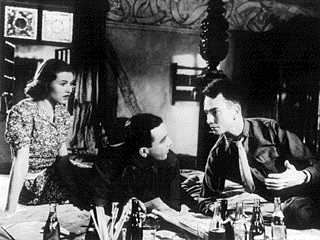
A tribute to beauty and country tradition in the County of Kent
where Michael Powell was born. It is also a poetic portrait of
England in times of war. In the manner of Chaucer, three modern
pilgrims make their way to Canterbury. They are drawn to a man
who throws glue on the hair of women who go out with American
soldiers.
Cast: Eric Portman, Sheila Sim, Dennis Price, Sargento
John Sweet, Esmond Knight
B&W, 95 min., 1944
Black Narcissus
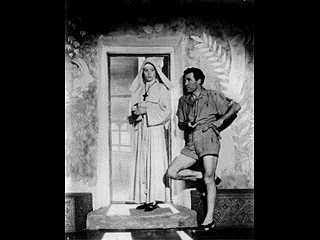
Based on Rumer Godden's book and filmed entirely in a studio,
the story tells of the difficulties encountered by a group of
Anglican nuns who wish to build an outpost in the Himalayas. Repressed
sexuality and the mystical powers of nature are expressed in the
colors of the film that earned Jack Cardiff the Oscar for best
photography of the year.
Cast: Deborah Kerr, Flora Robson, Jenny Laird, Kathleen
Byron, Esmond Knight, Sabu, David Farrar, Jean Simmons
Col., 100 min., 1947
The Red Shoes
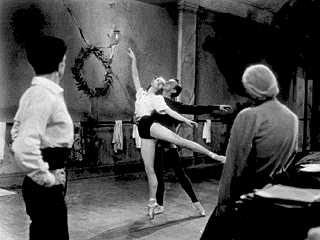
Regarded as the best film on ballet of all times. With exteriors
filmed in Covent Garden, in London, in the Opera House in Paris
and in Monte Carlo, the film is based on a story by Hans Christian
Andersen. Composer Marius Goring and empresario Anton Walbrook
contend for the love of Moira Shearer, in her first film. This
is a rhapsody of expressionist color, with scenes of ballet that
are sheer beauty.
Cast: Moira Shearer, Marius Goring, Anton Walbrook,
Leonide Massine, Esmond Knight, Ludmilla Tcherina, Robert Helpmann
Col., 134 min., 1948
The Small Back Room
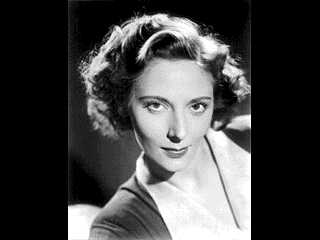
A classical suspense movie on an expert in deactivating explosives,
physically handicapped, and an alcoholic, who must win out on
one final hurdle: a German bomb triggered to go off. The sequence
is one of the most remarkable in the history of film making. David
Farrar and Kathleen Byron who were so great a success in The
Black Narcissus are the central pair. The film includes a
dream scene with bizarre special effects.
Cast: David Farrar, Kathleen Byron, Michael Gouch, Cyril
Cusack, Sidney James, Leslie Banks, Jack Hawkins, Robert Morley,
Bryan Forbes, Michael Powell
[Micky did appear in some films but not The Small Back Room]
B&W, 106 min., 1949
The Elusive Pimpernel

The film was originally intended to be a musical; however,co-producer
Samuel Goldwyn and Alexander Korda insisted that the operetta
touches be removed. Even so, it is a delight to watch this masterpiece
on the eccentricities of the eighteenth century set within a historical
background setting in England and in France. David Niven is unsurpassed
as a youth who frees aristocrats from the guillotine. Sardonic
humor.
[In fact Sam Goldwyn pulled out & Korda sued him]
Cast: David Niven, Margaret Leighton, Cyril Cusack,
Jack Hawkins, Arlette Marchal, Robert Coote, Patrick Macnee
Col., 109 min., 1950
The Tales of Hoffmann
Following on the success of The Red Shoes, Powell and Pressburger
adapted the Jacques Offenbach opera to a show with the participation
of the greatest dancers of the times. Besides Shearer, Massine,
Helpmann and Tcherina, the cast included singers Robert Rounseville,
and Ann Ayars. The chorus is Sadler's Wells with orchestra conducted
by Sir Thomas Beecham. The color and setting are surrealistic.
This is one of the greatest of the Powell/Pressburger films.
Cast: Moira Shearer, Leonide Massine, Pamela Brown,
Robert Helpmann, Robert Rounseville, Ludmilla Tcherina
Col., 118 min., 1951
The Spy in Black
The first Powell/Pressburger joint contribution based on a book
by J. Storer Clouston (script by Pressburger and Roland Pertwee).
An officer from the German navy and spy (Conrad Veidt) becomes
involved with a charming double agent (Valerie Hobson) in Scotland
during the course of World War I. The end to the story is surprising.
The following year Veidt and Hobson were once more brought together
by the directors in Contraband.
Cast: Conrad Veidt, Valerie Hobson, Sebastian Shaw,
Marius Goring, June Duprez, Helen Hayes, Cyril Raymond, Hay Petrie.
B&W, 82 minutes, 1939
49th Parallel/The Invaders
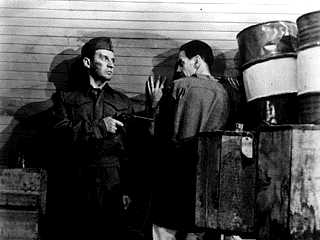
An exciting adventure during World War II when a group of soldiers
[sailors]
is driven aground with their war ship
[submarine]
along the coast of Canada.
A film rich in suspense and a great performance on the part of
the actors. An Oscar for the best story to Emeric Pressburger
(script by Pressburger and Rodney Ackland).
Cast: Anton Walbrook, Eric Portman, Leslie Howard, Raymond
Massey, Laurence Olivier, Glynnis Johns, Niall MacGinnis, Finlay
Currie.
B&W, 123 min., 1941
A Matter of Life and Death/Stairway to Heaven
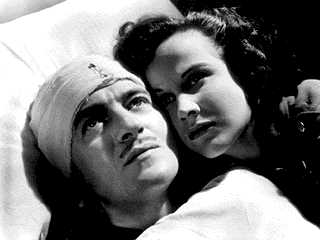
Powell and Pressburger knew as no one else how to combine reality
and fantasy. In this admirable original story in World War II,
an English pilot (David Niven) believes that he was chosen to
die by mistake and demands that a Celestial Court restore him
to life. All of this takes place while the pilot is under anesthetic
for surgery.
Cast: David Niven, Kim Hunter, Raymond Massey, Roger
Livesey, Robert Coote, Marius Goring, Richard Attenborough.
Col., 104 min., 1946








